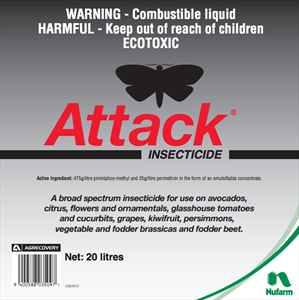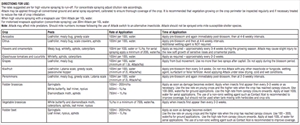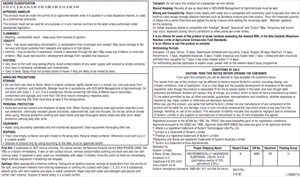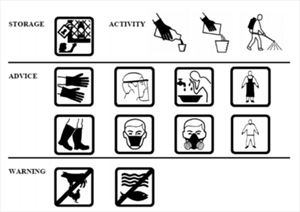The right panel contains information on safety precautions, first aid, and disposal. It may contain some of the items listed below:
Hazard class: These numbers are codes that apply to the Hazardous Substances and New Organisms Act of New Zealand; for instance, 3.1D is Flammable liquid - low hazard (physical); 6.4A is Substances that are irritating to the eye (health); and 9.3A Substances that are very ecotoxic to terrestrial vertebrates (environmental). The WHO has a different set of hazard classes for health, based on eating or drinking the chemical and its effect on skin (on rats): 1a extremely hazardous; 1b highly hazardous; II moderately hazardous; III slightly hazardous; U unlikely to present acute hazard.
The WHO has introduced another system, the GHS classification - Globally Harmonised System of Classification and Labelling of Chemicals - with five categories, based on toxicity of chemicals to rats.
Approved handler: People using the product must be registered; usually this means they should be trained pesticide operators. In many countries, people who apply pesticides must be registered before they can buy and apply pesticides. Also, the product must not be used in any other way than stated in the label, without appropriate authority.
Storage: Store the product in its original container, tightly closed, and away from heat, food and out of reach of children, preferably in a locked cupboard. In New Zealand, there are different rules depending on the amount of product stored in one place.
Protective clothing: This covers the equipment and clothing that should be worn when mixing and applying pesticides, e.g., masks (including respirators) and goggles to protect mouth and eyes, gloves, boots, hat and overalls. After spraying, clothing should be removed and hands and face washed. Clothes used when spraying should be washed separately. Do not eat, drink or smoke when spraying.
Disposal: Notes on how to clean the sprayer, and dispose of the washings (usually by spraying on soil at the side of the field, away from humans and livestock). How to deal with the container when empty; how to clean it first and then either bury it or send it to a landfill. Do not re-use the container.
First aid: What to do and who to contact if the product is swallowed, skin or hair is contaminated, or the chemical is splashed into the eyes. Usually, a doctor would be called, clothing removed and skin and eyes flushed with water. Depending on the pesticide, the label says whether vomiting should be induced or not. If inhaled, victims should be moved to fresh air, and given CPR (cardiopulmonary resuscitation) if the heart stops beating.
Spillage: What to do if a spill occurs. Wear protective clothing, cordon off the area, prevent the chemical from entering drains, and absorb it with inert material, and place it in bins for disposal in a landfill. Wash contaminated area with water.
Transport: How the chemical should be transported, especially whether public vehicles can be used.
Pictograms: These are precautionary symbols with messages without the use of words (Diagram). A number have been devised by FAO.







